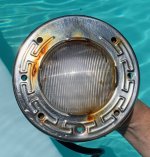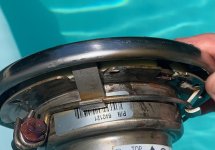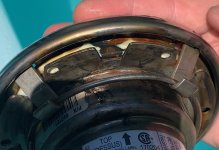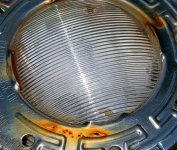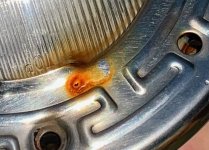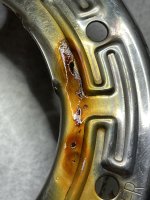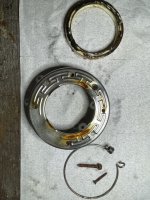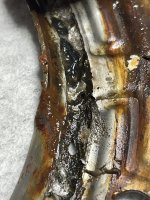I have a fiberglass pool with a Pentair Intellabrite 5G spa light. After a year or so of owning the pool I started to see some rust colored junk on the face plate of the light. I removed the light from niche to clean and unleashed a giant plume of algae. After lots of scrubbing on the pool deck with a brush on the light and using Bar Keepers Friend on the faceplate, I was able to clean everything up and reinstall the light.
I repeated the same process at the start of this season, and I left the light out of the niche during my initial SLAM to start the season. Unfortunately, rather than waiting 1-2 years to clean the light again, within a couple of months I had to repeat the process. Again, there was lots of orange-brown rust colored junk on the outside. When I opened the niche it was completely full of black algae. After cleaning that time, within a few weeks the orange-brown growth has reemerged on the face plate. During all this time I've kept the FC at the high end of the TFP guidance using a SWG.
Questions:
Is such frequent cleaning typical? I'm sure what is happening is that I'm just not getting rid of all the algae. Exponential growth to a noticeable amount takes much less time if there some significant algae to start with.
The Pentair light has lots of nooks and crannies on the backside that I can't get completely clean without disassembling the lens/gasket. Should I just disassemble every time and replace the gasket? What about setting the light in a bucket of bleach water on the pool deck for a couple of hours? I'm reluctant to do this for fear of damaging the light, but maybe others have experience.
Any advice or wisdom is welcome - thank you!
Matt
I repeated the same process at the start of this season, and I left the light out of the niche during my initial SLAM to start the season. Unfortunately, rather than waiting 1-2 years to clean the light again, within a couple of months I had to repeat the process. Again, there was lots of orange-brown rust colored junk on the outside. When I opened the niche it was completely full of black algae. After cleaning that time, within a few weeks the orange-brown growth has reemerged on the face plate. During all this time I've kept the FC at the high end of the TFP guidance using a SWG.
Questions:
Is such frequent cleaning typical? I'm sure what is happening is that I'm just not getting rid of all the algae. Exponential growth to a noticeable amount takes much less time if there some significant algae to start with.
The Pentair light has lots of nooks and crannies on the backside that I can't get completely clean without disassembling the lens/gasket. Should I just disassemble every time and replace the gasket? What about setting the light in a bucket of bleach water on the pool deck for a couple of hours? I'm reluctant to do this for fear of damaging the light, but maybe others have experience.
Any advice or wisdom is welcome - thank you!
Matt


